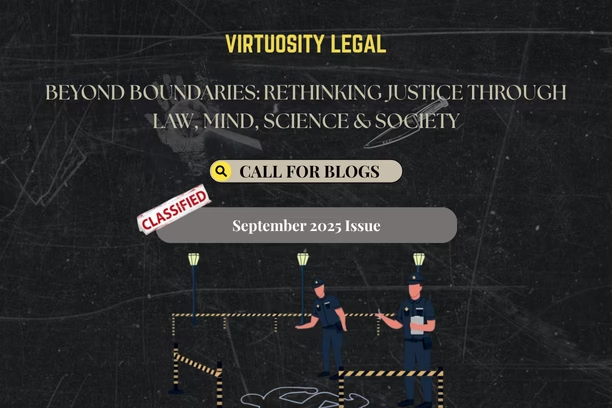Abstract
This article traces the origins and development of therapeutic jurisprudence and healing-centred jurisprudence, two movements that have transformed the face of law by proposing a move from penal to restorative and rehabilitative paradigms of justice. Therapeutic jurisprudence, pioneered by David Wexler in 1987, focuses on the psychology of law processes and draws attention to law professionals as therapeutic providers.
It stresses procedural justice, preventive law measures, and multi-disciplinary engagement, contending that law must promote rather than harm individuals and collectives. Healing-centered jurisprudence, informed by trauma studies and indigenous knowledge, augments this vision by contending that justice apparatuses must broach fundamental societal maladies such as poverty and historical trauma.
For India, these ideals manifest in landmark judgments such as Sunil Batra v. Delhi Administration by the Supreme Court, which highlighted prisoner dignity and reform over retaliation. Current reforms such as Bhartiya Nagarik Suraksha Sanhita, 2023, and Juvenile Justice Act, 2015, demonstrate India’s tentative but steady bent toward therapeutic and restorative paradigms.
This article posits that long-term law, institutional, and educational reforms will help create humane law and order system that places healing, dignity, and purposeful rehabilitation above all other considerations.
Introduction
Therapeutic jurisprudence and healing-focused jurisprudence are revolutionary paradigms which redefine law as a vehicle for healing as opposed to simple penalization. While therapeutic jurisprudence was born out of David Wexler’s 1987 writings on the psychology of law’s procedural impacts[i], healing-focused jurisprudence was informed by community grounded studies of trauma and indigenous models of justice. Both frameworks call for intentional models of law that encourage human dignity, mental health, and restorative solutions over simple retribution.
Foundational axis of Therapeutic Jurisprudence
Therapeutic jurisprudence works on four fundamental premises. Firstly, all legal actors’ judges, lawyers, and court staff unknowingly or unwittingly act as therapeutic agents. Secondly, procedural justice becomes all-important where process frequently trumps outcomes. Thirdly, it argues for “preventive law” strategies that prevent clients from getting into legal issues in the first place, such as preventive medicine. Lastly, it argues for interdisciplinary engagement where psychology, social work, and behavioural sciences provide lessons for legal practice.
Healing-centred jurisprudence takes a broader view that recognizes traditional judicial proceedings themselves often induce traumatization, particularly among already marginalized peoples. While therapeutic jurisprudence significantly overhauls existing legal frameworks, healing-centred models prefer to create other sites where justice occurs with greater weighting given to voices of communities, cultural protocols, and social responsibility. This paradigm recognizes that crimes involving individuals frequently represent larger social conditions such as poverty, racism, and historical traumatization and entail treating both immediate harm and ground conditions.
The restorative theory is an emerging approach that focuses on restoring the harm caused by criminal conduct. It seeks to involve the victim, offender, and community in a dialogue to heal the wounds of crime. The aim is to bring about reconciliation and accountability rather than punishment for its own sake.[ii]
While not fully integrated into India’s mainstream criminal justice system, restorative practices are increasingly gaining attention, especially in juvenile justice, family disputes, community policing, and Lok Adalat’s. Mediation and conciliation in compoundable offences under the CrPC are also reflective of this model.
The Landmark Sunil Batra Judgment
This decision in Sunil Batra v. Delhi Administration (1978)[iii] remains India’s foremost contribution to therapeutic jurisprudence.
The writ was initiated through a letter written by death convict Sunil Batra to a Supreme Court judge accusing one warder from one of the prisons in India’s capital city of having brutally tortured another convict. Instead of dismissing such an unconventional writ petition, the Supreme Court accepted it as one and instituted fresh Habeas corpus proceedings radically changing India’s jurisprudence pertaining to prisoner rights.
Justice Krishna Iyer, in writing for the Constitutional Bench, issued a verdict reflecting therapeutic jurisprudence thinking long before the phrase became popular. The court ruled that “Fundamental rights under Articles 14, 19, and 21 do not cease after conviction, although they could reasonably be restricted by reason of incarceration.[iv]” Above all, the verdict ruled that inmates had to be treated with dignity and respect and decried inhuman conditions and tortures as denial of Article 21’s right to life and personal liberty.
The therapeutic implications of this judgment were deep. The Court recognized that “The purpose of punishment is not vengeance but reformation“[v] and emphasized that harsh prison conditions could be counterproductive for rehabilitation and social reintegration.
By directing weekly judicial visits to prisons, establishing grievance mechanisms, and mandating free legal aid for prisoners, the judgment created a framework for ongoing therapeutic intervention within the correctional system.[vi] The Court’s observation that prisons should function as “Correctional homes, not Punitive institutions” anticipated modern therapeutic jurisprudence by emphasizing healing over harm.
Trends Now and Integrative Legislation
The shift to new criminal laws by India via the Bhartiya Nagarik Suraksha Sanhita, 2023[vii] (in place of the Criminal Procedure Code) includes various restorative justice measures consistent with therapeutic ones.
Section 289[viii] provides for plea bargaining processes emphasizing agreed resolution over adversarial hearings.
Section 357[ix] requires victim compensation schemes acknowledging victims’ necessities over punishing offenders.
Section 359[x] broadens compounding offenses so parties may settle specified disputes by consent instead of state-authored penalty.
The Juvenile Justice (Care and Protection of Children) Act, 2015[xi] is India’s most substantial expression of therapeutic jurisprudence principles. The Act requires Juvenile Justice Boards to prefer counselling, community service, and victim-offender mediation over incarceration. By specifically favouring rehabilitation over retribution, law exhibits therapeutic jurisprudence’s fundamental principle of analysing law’s mental influence upon individuals and collectives.
“Indian family courts have been increasingly resorting to therapeutic intervention, with the majority mandatorily requiring compulsory counselling and mediation before they grant divorce. This practice reflects therapeutic jurisprudence’s concern for procedural justice and knowledge that how things turn out in process often becomes no less crucial than what they provide.[xii]”
Challenges and Implementation Lapses
Despite legislative progress, implementation problems continue. Scholarship finds that therapeutic jurisprudence is fundamentally “recommendatory” in Indian courts and not integrated in a systematic fashion.[xiii]
Lack of proper special statutory measures for therapeutic intervention, lack of proper training of judicial officers on issues related to trauma-sensitive practices, and limitations on resources hinder effective realization.
Over-crowding in jail cells, as jails in India experience close to 131.4% occupancy rates[xiv], inhibits therapy interventions. An inadequacy of specialists in mental health among individuals in the judicial system along with societal stigma imposed upon released inmates continues to hinder rehabilitation. Furthermore, adversarial preparation among legal specialists frequently runs counter to teamwork and healing practices.
Prospective Directions
The way ahead is all-encompassing reforms in various directions. Legal education must incorporate therapeutic jurisprudence principles, educating lawyers to be about trauma informed practice and preventive counselling.
Training programs for judges must focus on the mental consequences of the judicial process and encourage practices that save dignity.
Institutional change would involve developing specialized therapy courts in conjunction with juvenile jurisdictions, initiating interdisciplinary taskforces involving mental health and law experts’ side by side, and introducing victim-focused practices blending healing and accountability.
Such indigenous models as Lok Adalat’s and traditional Panchayat dispensations offer culture-based precedents for healing-focused models that might incorporate contemporary therapy models.
The recent focus by the Supreme Court on victim compensation in such matters as Ankush Shivaji Gaikwad v. State of Maharashtra (2013)[xv] “While the award or refusal of compensation under Section 357 of Code of Criminal Procedure, in a particular case may be within the Court’s discretion, there exists a mandatory duty on the Court to apply its mind to the question in every criminal case. Application of mind to the question is best disclosed by recording reasons for awarding/refusing compensation.[xvi]”
The Court further observed that Section 357 CrPC “confers a power coupled with a duty on the Courts to apply its mind to the question of awarding compensation in every criminal case” and established that the power to award compensation “is not ancillary to other sentences but it is in addition thereto.”
Conclusive Statement
Indian law is at crossroads where historical models of retribution tend to yield gradually to healing-focused and therapeutically oriented paradigms. The lingering aftermath of Sunil Batra’s judgment and fresh legislative interventions and change in judicial leanings provide leeway for paradigm shift.
This vision is ensured through sustained investments in training, infrastructure building, and cultural developments among legal professionals.
For India grappling with rising mental health issues and social inequalities, therapeutically oriented and healing-focused models open windows toward a more humane, effective, and dignified system of justice that addresses not mere individual parties to proceedings but entire societies crying out for remedial relief from histories and contemporary injuries.
Personal Experience
My own exposure to therapeutic jurisprudence was through my exposure to the Aligarh District Jail along with my faculty. There, I saw many efforts on the part of the authorities to promote rehabilitation rather than punishment. Reformation and retribution appeared to be the focus through workshops, vocational centres, and recreational facilities such as a gym and community kitchen where inmates cooked together. All these efforts illustrated a positive step towards applying therapeutic jurisprudence through practice.
But with these efforts in place, conditions for living were not quite satisfactory. As one of my colleagues asked about mental health among inmates, the jail official retorted with a chuckle, stating that in a situation where it is itself a task to provide two meals per day, it is unrealistic to expect mental health care. This reply was illustrative of how institutional intent lags so far behind institutional ability. Though India is progressing towards embracing therapeutic jurisprudence, much remains to be achieved to meet immediate realities of incarceration.
Endnotes
[i] Wexler, D. B. (1987). Therapeutic jurisprudence and the criminal courts. William & Mary Law Review, 35(1)
[ii] Akshit Sharma, “CRIMINAL JUSTICE SYSTEM IN INDIA WITH SPECIAL REFERENCE TO PUNISHMENT THEORY” Vol 6 International Journal of Research Publication and Reviews 12521 (2025). available at: https://ijrpr.com/uploads/V6ISSUE5/IJRPR46408.pdf#:~:text=restorative%20theory%20is%20an%20emerging%20approach
[iii] (1978) 4 SCC 494; AIR 1978 SC 1675.
[iv] Justice Krishna Iyer in Sunil Batra v. Delhi Administration (1978) 4 SCC 494
[v] Ibid.
[vi] Ibid.
[vii] Bhartiya Nagarik Suraksha Sanhita, 2023, Act No. 45 of 2023.
[viii] BNSS Section 289
[ix] BNSS Section 357
[x] BNSS Section 359
[xi] Juvenile Justice (Care and Protection of Children) Act, 2015, Act No. 2 of 2016.
[xii] B Leelesh Sundaram and Siddhi S, ‘The Study on the Application and Implementation of Therapeutic Jurisprudence in Family Laws with Respect to Divorce in India’ (2017) 4(3) International Journal of Research and Analytical Reviews 311, 314
[xiii] Ibid.
[xiv] Bureau of Police Research and Development, Overcrowding in Prisons (Government of India 2024); India Justice Report 2025 available at: https://indiajusticereport.org/files/IJR%204_Full%20Report_English_Low.pdf 73-77
[xv] Ankush Shivaji Gaikwad v. State of Maharashtra, (2013) 6 SCC 770.
[xvi] Ibid.


Leave a Reply